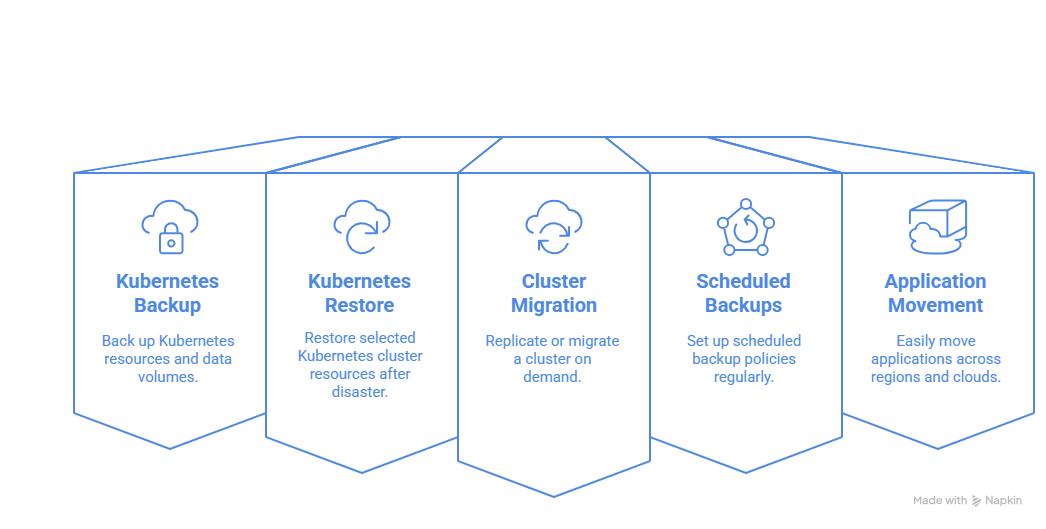
In the last few years, Kubernetes has been adopted by a significant number of enterprises as their default container orchestration tool. Most enterprises are now comfortable with running applications and services in the Cloud. While the Cloud provides flexibility and agility, organizations must not lose sight of the fact that protecting and backing up the entire customer infrastructure blueprint and containerized application deployment is still the customer's responsibility.
Offering Cloud-native Disaster Recovery “as a service” is a modern approach to traditional Disaster Recovery that is low-cost and on-demand. It is optimized to maximize the utilization of Cloud resources for business continuity, scalability, and application mobility in hybrid and Multi-Cloud environments.
What Does Cloud-Native Mean?
Before exploring Disaster Recovery, it’s worth defining "Cloud-native." Cloud-native refers to applications and services designed to fully exploit Cloud computing capabilities, such as scalability, elasticity, and resilience. Typically containerized and managed by Kubernetes, these applications are built to thrive in dynamic Cloud environments, often spanning multiple regions or providers.

Why Disaster Recovery Matters for Cloud-Native Applications
Disaster recovery (DR) is crucial for cloud-native applications, as they often underpin essential business operations. These applications are expected to be highly available, meaning any downtime can result in significant financial or reputational damage. The dynamic nature of cloud environments introduces multiple potential failure points, ranging from individual container failures to entire data center outages. A robust Disaster Recovery strategy ensures rapid recovery, maintaining business continuity even in the face of unexpected disruptions.
Challenges Enterprises Face while Adopting a Disaster Recovery Strategy
Given that most Kubernetes workloads are spread across public, private, and hybrid Cloud infrastructures, backing up and protecting these deployments is often a customized, expensive, and complex process, and prone to misconfigurations.
Most Disaster Recovery solutions today are complex, expensive, and lack flexibility. Customers often require multiple tools, custom scripts, and specialized DevOps experts to set up and manage the Disaster Recovery (DR) process. The more tools and custom scripts you need to set up DR, the tighter the recovery point objectives and the higher the costs. Moreover, it becomes difficult to keep backups in sync when different tools are utilized, and it is also challenging to manage multiple backups across multiple environments.
VPC+ Disaster Recovery as a Service by Wanclouds
VPC+ DRaaS by Wanclouds is a SaaS-based offering that enables you to discover, backup, migrate, and restore your cloud-native or Kubernetes application deployments across hybrid and multi-cloud environments.
VPC+ DRaaS gives you the ability to:
- Backup your Kubernetes resources and data volumes for an entire cluster or parts of a cluster.
- Restore your selected or entire Kubernetes cluster resources in case of any disaster
- Replicate or Migrate a cluster on demand.
- Set up scheduled backup policies at recurring intervals.
- Easily move your application and deployments across regions and clouds with just a few clicks.

Getting Started
Wanclouds is a leading Multi-Cloud SaaS solution and Managed Cloud Service provider. It helps enterprises with cloud deployments, migrations, and protecting their Cloud infrastructure in a time and cost-efficient way.
Our Cloud Migration as a Service (MaaS) and Disaster Recovery as a Service (DRaaS) reduce financial investment and remove the technical complexities that hinder or delay businesses from migrating on-premises to the cloud, moving across clouds, or setting up backup and restore protection.
Additionally, our SaaS-based automation suite, VPC+, offers a single pane of glass for managing and protecting multi-cloud environments through a centralized, cross-cloud solution.
For more information, please visit our website, review our Data Sheets, or watch our product demos. To initiate contact, you can fill out our Request form or contact one of our sales representatives at [email protected]